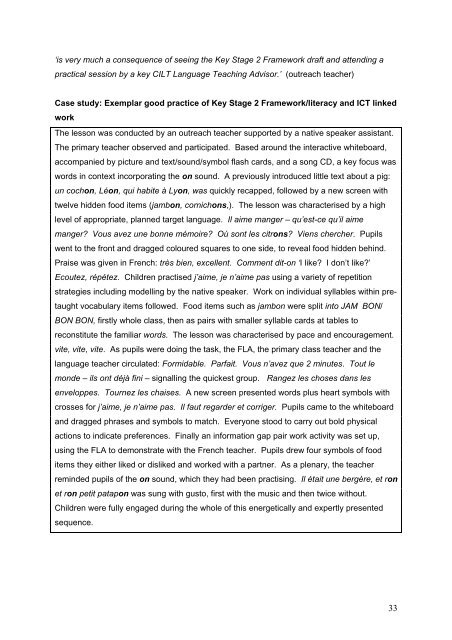Evaluation of the Key Stage 2 Language Learning Pathfinders
Evaluation of the Key Stage 2 Language Learning Pathfinders
Evaluation of the Key Stage 2 Language Learning Pathfinders
Create successful ePaper yourself
Turn your PDF publications into a flip-book with our unique Google optimized e-Paper software.
‘is very much a consequence <strong>of</strong> seeing <strong>the</strong> <strong>Key</strong> <strong>Stage</strong> 2 Framework draft and attending apractical session by a key CILT <strong>Language</strong> Teaching Advisor.’ (outreach teacher)Case study: Exemplar good practice <strong>of</strong> <strong>Key</strong> <strong>Stage</strong> 2 Framework/literacy and ICT linkedworkThe lesson was conducted by an outreach teacher supported by a native speaker assistant.The primary teacher observed and participated. Based around <strong>the</strong> interactive whiteboard,accompanied by picture and text/sound/symbol flash cards, and a song CD, a key focus waswords in context incorporating <strong>the</strong> on sound. A previously introduced little text about a pig:un cochon, Léon, qui habite à Lyon, was quickly recapped, followed by a new screen withtwelve hidden food items (jambon, cornichons,). The lesson was characterised by a highlevel <strong>of</strong> appropriate, planned target language. Il aime manger – qu’est-ce qu’il aimemanger? Vous avez une bonne mémoire? Où sont les citrons? Viens chercher. Pupilswent to <strong>the</strong> front and dragged coloured squares to one side, to reveal food hidden behind.Praise was given in French: très bien, excellent. Comment dit-on ‘I like? I don’t like?’Ecoutez, répétez. Children practised j’aime, je n’aime pas using a variety <strong>of</strong> repetitionstrategies including modelling by <strong>the</strong> native speaker. Work on individual syllables within pretaughtvocabulary items followed. Food items such as jambon were split into JAM BON/BON BON, firstly whole class, <strong>the</strong>n as pairs with smaller syllable cards at tables toreconstitute <strong>the</strong> familiar words. The lesson was characterised by pace and encouragement.vite, vite, vite. As pupils were doing <strong>the</strong> task, <strong>the</strong> FLA, <strong>the</strong> primary class teacher and <strong>the</strong>language teacher circulated: Formidable. Parfait. Vous n’avez que 2 minutes. Tout lemonde – ils ont déjà fini – signalling <strong>the</strong> quickest group. Rangez les choses dans lesenveloppes. Tournez les chaises. A new screen presented words plus heart symbols withcrosses for j’aime, je n’aime pas. Il faut regarder et corriger. Pupils came to <strong>the</strong> whiteboardand dragged phrases and symbols to match. Everyone stood to carry out bold physicalactions to indicate preferences. Finally an information gap pair work activity was set up,using <strong>the</strong> FLA to demonstrate with <strong>the</strong> French teacher. Pupils drew four symbols <strong>of</strong> fooditems <strong>the</strong>y ei<strong>the</strong>r liked or disliked and worked with a partner. As a plenary, <strong>the</strong> teacherreminded pupils <strong>of</strong> <strong>the</strong> on sound, which <strong>the</strong>y had been practising. Il était une bergère, et ronet ron petit patapon was sung with gusto, first with <strong>the</strong> music and <strong>the</strong>n twice without.Children were fully engaged during <strong>the</strong> whole <strong>of</strong> this energetically and expertly presentedsequence.33

















